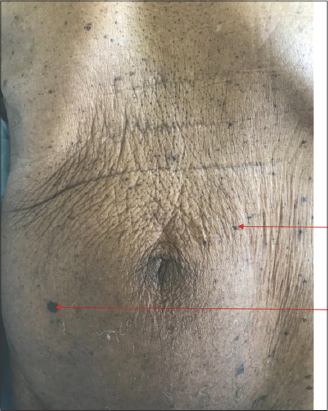Leser–Trélat syndrome and squamous cell carcinoma of the bladder
Ida Aurélie Lenga Loumingou 1, Almamy Diabaté2, Yannick Ijosdi Dimi Nyanga3
1, Almamy Diabaté2, Yannick Ijosdi Dimi Nyanga3
1Department of Dermatology, University of Brazzaville Medical Center, Brazzaville, Republic of the Congo, 2Department of Dermatology, CHU de Bouaké, Université Alassane Ouattara, Bouaké, Côte d’Ivoire, 3Department of Urology, University of Brazzaville Medical Center, Brazzaville, Republic of the Congo
Corresponding author: Ida Aurélie Lenga Loumingou, MD
Submission: 22.01.2022; Acceptance: 05.04.2022
DOI: 10.7241/ourd.20223.29
Cite this article: Lenga Loumingou IA, Diabaté A, Dimi Nyanga YI. Leser–Trélat syndrome and squamous cell carcinoma of the bladder. Our Dermatol Online. 2022;13(3):334-335.
Citation tools:
Copyright information
© Our Dermatology Online 2022. No commercial re-use. See rights and permissions. Published by Our Dermatology Online.
Sir,
Paraneoplastic syndromes are contemporaneous with various malignant tumors. Leser–Trélat syndrome is a paraneoplastic syndrome associated with certain cancers, notably, breast, lung, kidney, hepato-digestive, melanoma, and lymphoma [1].
The pathogenesis of Leser–Trélat syndrome remains unknown. Exceptional observations associate Leser–Trélat with bladder carcinoma [2].
Herein, we report Leser–Trélat syndrome in a 75-year-old black patient with bladder carcinoma.
The aim of this work is to report an unusual association.
The patient was a 75-year-old male, a non-smoker, with no previous history, admitted to the urology department of the Brazzaville Hospital for bladder carcinoma. The tumor suspected on ultrasound was documented by anatomopathological examination.
The incidental discovery of a rash of diffuse pigmented papules located preferentially on the trunk, consisting of lesions of variable size, measuring from 3 to 1 cm, with a soft or firm consistency and irregular surface (Fig. 1). These lesions were suggestive of seborrheic keratoses.
 |
Figure 1: Multiple seborrheic keratoses of the trunk. |
Leser–Trélat syndrome is rare, described in 1800 by Edmond Leser and Ulysse Trélat, updated in 1900 by Hollander, and for some authors is hypothetical, defined as a sudden eruption of seborrheic keratoses contemporary with a malignant tumor [3]. These tumors are carcinomas, melanomas, or lymphomas [3]. Seborrheic keratoses are considered a variant of dermatosis papulosa nigra, which has less voluminous lesions and is specific to pigmented skin [4].
The first association of Leser–Trélat syndrome with bladder carcinoma was reported in 1994 by Yaniv [2].
Seborrheic keratoses in elderly individuals are typical. The average age of a patient with bladder cancer is 60–70 years [5].
The relevance of a link between seborrheic keratoses and bladder carcinoma may be argued by the data in the literature [2], and then by the explosive character of the skin rash. This link may be confirmed by the search for specific antibodies (epidermal growth factor, inhibiting growth factor, and transforming growth factor alpha) followed by immunohistochemical analysis of the keratoses revealing the epidermal growth factor receptor [1,5].
The interest of this observation is to report an exceptional association of Leser–Trélat syndrome with bladder carcinoma and to remind the necessity to look for a malignant tumor in front of an explosion of seborrheic keratoses.
Consent
The examination of the patient was conducted according to the principles of the Declaration of Helsinki.
The authors certify that they have obtained all appropriate patient consent forms, in which the patients gave their consent for images and other clinical information to be included in the journal. The patients understand that their names and initials will not be published and due effort will be made to conceal their identity, but that anonymity cannot be guaranteed.
REFERENCES
1. Ponti G, Luppi G, Losi L, Giannetti A, Seidenari S. Leser–Trélat syndrome in patients affected by six multiple metachronous primitive cancers. J Hematol Oncol. 2010;3:2.
2. Yaniv R, Servadio Y, Feinstein A, Trau H. The sign of Leser–Trélat associated with transitional cell carcinoma of the urinary bladder:A case report and short review. Clin Exp Dermatol. 1994;19:142-5.
3. Bernett CN, Schmieder GJ. Leser–Trélat sign. 2021 Sep 19. In:StatPearls [Internet]. Treasure Island (FL):StatPearls Publishing;2022 Jan.
4. Metin SA, Lee BW, Lambert WC, Parish LC. Dermatosis papulosa nigra:A clinically and histopathologically distinct entity. Clin Dermatol. 2017;35:491-6.
5. Didona D, Didona B, Fania L, Bidonna B, Eming R, Hertl M. Paraneoplastic dermatoses:A brief general review and an extensive analysis of paraneoplastic pemphigus and paraneoplastic dermatomyositis. Int J Mol Sci. 2020;21:2178.
Notes
Source of Support: Nil,
Conflict of Interest: None declared.
Request permissions
If you wish to reuse any or all of this article please use the e-mail (brzezoo77@yahoo.com) to contact with publisher.
| Related Articles | Search Authors in |
|
|



Comments are closed.